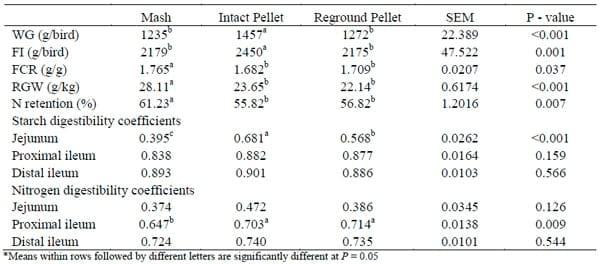I. INTRODUCTION
The present study is an extension of an earlier experiment (Selle et al., 2012) which investigated the shortcomings of the grain sorghum as a feedstuff for poultry. One reason for the inferiority of sorghum relative to wheat proposed by Black et al. (2005) was a lack of synchrony in starch and protein digestion. The gastrointestinal tract has a substantial energy demand (Cant et al., 1996), which is largely met by the oxidation of luminal non-essential amino acids (Reeds et al., 1999); whereas, glucose is required for the stimulation of protein accretion in breast muscle (Yaman et al., 2000). Thus, the relative availability of glucose or amino acids, arising from different starch and protein digestion rates, may influence both nutrient absorption and protein deposition. In practice, broilers have unrestricted access to feed and ad libitum feeding regimes are often thought to accommodate any differences in rates of digestion/absorption of nutrients. However, ad libitum feeding does not equate with continuous feeding because birds fed pelleted diets spent less than 5% of illuminated time eating under a '12 hours-on' lighting pattern (Jensen et al., 1962). Thus despite unrestricted access to feed it does appear that consumption patterns still provide scope for asynchronies in digestion and absorption to impact on broiler performance. Therefore, this study investigated the digestion kinetics of starch and nitrogen and related them to 6-27 days post-hatch broiler performance with feed access dictated by an '18 hours-on' lighting regime.
II. MATERIALS AND METHODS
The general methodology used in this experiment has been outlined previously (Selle et al., 2012) and is not repeated herein. Specifically, digesta samples were collected in their entirety from the proximal jejunum, proximal ileum and distal ileum, freeze-dried and weighed to determine mean retention time (MRT) and apparent digestibility of starch and nitrogen (N) using acid insoluble ash (AIA) as the inert dietary marker. The digestion time (t) was calculated from the sum of MRT determined in each intestinal segment. Mean retention time was calculated using the following equation:
MRT (min) = (1440 (min) × AIAdigesta × W(g)) / FI24hr × AIAfeed
where AIAdigesta is the AIA concentration in the digesta (mg/g), W is the weight of dry gut content (g), FI24hr is the feed intake over 24 h before sampling (g), AIAfeed is the AIA concentration in the feed (mg/g) and 1440 equals minutes per day. On average, MRT in proximal jejunum, proximal ileum and distal ileum were 16, 35 and 41 min, respectively. Mean retention time in the duodenum and distal jejunum was not determined but were taken as 5 and 41 min, respectively, based on two other sorghum studies completed by the Poultry Research Foundation (unpublished data).
The pattern of fractional digestibility coefficients was described by relating the digestion coefficient at each site with the digestion time (t). The curve of digestion was described by the exponential model developed by Orskov and McDonald (1979):
Dt = D∞ ( 1 − e−kt ) (1)
where Dt (g/100g starch or nitrogen) is the percentage of starch/nitrogen digested at time t (min), the fraction D∞ is the amount of potential digestible starch or nitrogen (asymptote) (g/100g starch or nitrogen), digestion rate constant k (per unit time, h-1) would mean a 100 % starch digestion within 1 hour when it is equal to 1. Starch absorption was assumed not to take place proximal to the small intestine. Nitrogen digestion in this study was determined as apparent N digestibility, which unlike starch, is impacted by endogenous N flows.
The glycaemic indices are the area under the digestogram (AUC), which is obtained by integrating Eq. (1) between digestion times t1 (usually t = 0) and t2 (Eq. 2):
This is because correlation between glycaemic index (GI) and hydrolysis index (HI), GI = 39.71+ 0549HI (r=0.894, P < 0.05) (Goni et al., 1997), where
is a fixed constant in this equation; therefore, AUC can be used as an indicator of glycaemic index. The Microsoft Excel Solver® was used to compute parameters of the modified firstorder kinetic (Eq. 1) by minimising the sums of squares of residuals with the constraint that D∞ ≤ 100%.
III. RESULTS
The previously reported growth performance and digestibility coefficients are shown in Table 1 (Selle et al., 2012) and the results of starch and nitrogen digestion kinetics are shown in Table 2. Starch and nitrogen were gradually digested along the small intestine, with starch being digested more rapidly than nitrogen in the jejunum. On average, the starch and nitrogen digestion rate constants were 2.02 and 1.36 (× 10-2 h-1), respectively. Birds fed intact pelleted diets had superior weight gain and feed efficiency, which was associated with the highest feed intakes and most rapid starch and nitrogen digestion rates. Pearson correlations between digestion kinetics and reported parameters of broiler performance are shown in Table 3. Starch digestion rate and glycaemic response were positively correlated with weight gain. Birds with heavier relative gizzard weight had higher nitrogen digestion rate and potential digestible nitrogen. The rate of glucose absorption, as per the predicted glycaemic index (AUC), was highly correlated (r = -0.710, P < 0.002) with enhanced feed efficiency. N retention was negatively correlated with starch digestion rate (r = -0.597, P < 0.01) and glycaemic response (r = -0.550, P < 0.02); however, it was not correlated with nitrogen digestion rate (P > 0.25).
IV. DISCUSSION
In this study, sorghum was coarsely-ground (6.0 mm hammer-mill sieve) prior to steampelleting and secondary reductions in particle size in the pellet press (4.0 mm) almost certainly influenced digestion rates. The starch digestion rate constant in reground mash was 51 % higher than unprocessed mash (2.10 vs. 1.39, × 10-2 h-1); similarly, the nitrogen digestion rate was 38 % higher in reground mash diets (1.31 vs. 0.95, × 10-2 h-1).
Table 1 - Effects of dietary treatments on growth performance [weight gain (WG), feed intake (FI), feed conversion ratio (FCR), relative gizzard weights (RGW), N retention], starch and N digestibility coefficients from 6-27 days post-hatch
Table 2 - Effects of dietary treatments on digestion kinetics [potential digestible starch (PDS), area under starch digestion curve (AUC), starch digestion rate (Kstarch), potential digestible nitrogen (PDN), nitrogen digestion rate (Knitrogen)]
Table 3 - Pearson correlations between digestion kinetics and broiler performance

Feed efficiency is pivotal to sustainable chicken-meat production. Feed conversion ratio was correlated with starch digestibility in the proximal jejunum (r = -0.517, P < 0.03) and proximal ileum (r = -0.554, P < 0.02), but not in distal ileum and FCR was not correlated with N digestibility in the previous study. However, there was a stronger correlation between FCR and glycaemic index than starch digestibility coefficients. The relevant linear regression equations predict an increase in glycaemic index from 89.36 to 125.80 will translate to a 4.5 % improvement in FCR (1.768 vs. 1.688) and an 11.1 % increase in weight gain (1239 vs. 1377 g/bird). Glucose triggers insulin secretion in a concentration-dependent manner via defined pathways (Henquin, 2000) and insulin prompts net protein deposition and moderates protein turnover (Grizard et al., 1999). Importantly, Tomas et al (1998) showed that protein turnover was negatively correlated with feed efficiency.
N retention was significantly correlated with starch but not nitrogen digestion rates; however, starch was more rapidly digested than nitrogen (2.02 vs. 1.36 units). As suggested by Black et al. (2005), asynchronies or imbalances in starch and protein digestion rates may compromise protein deposition and broiler performance. Therefore, rapid starch digestion, in concert with slow protein digestion, may have depressed N retention in this study. Instructively, Weurding et al. (2003) demonstrated that slowly digestible starch significantly improved feed efficiency (1.55 vs. 1.58 units) and weight gain (1426 vs. 1400 g/kg) compared with rapidly digested starch in 9-30 day broilers. Thus the balance of either slowly digestible starch (pea-maize) or rapidly digestible starch (tapioca-maize) in relation to protein (soybean meal) in the Weurding et al. (2003) study impacted on performance and protein utilisation.
Finally, in this study, broiler performance parameters were correlated with kinetics of starch and nitrogen digestion but not with digestibility coefficients of starch and nitrogen in the distal ileum. Therefore, the dynamics of starch and nitrogen digestion are more important determinants of performance than ileal nutrient digestibility coefficients and the latter value is limited because they are static assessments.
ACKNOWLEDGEMENTS: The authors acknowledge the financial support received from the RIRDC Chicken Meat Program for the sorghum project (PRJ-003810) of which this study formed a part. Also, we acknowledge the financial support of a post-graduate scholarship for Ms. Sonia Yun Liu awarded by the Poultry CRC.
REFERENCES
Black JL, Hughes RJ, Nielsen SG, Tredrea AM, MacAlpine R, van Barneveld RJ (2005) Proceedings, Australian Poultry Science Symposium 16, 21-29.
Cant JP, McBride BW, Croom WJ (1996). Journal of Animal Science 74: 2541-2553.
Goni I, GarciaAlonso A, SauraCalixto F (1997) Nutrition Research 17, 427-437.
Grizard J, Picard B, Dardevet D, Balage M, Rochon C (1999) In: Protein Metabolism and Nutrition, pp.184-187. EAAP Publication No. 96. Wageningen Pers.
Henquin JC (2000) Diabetes 49, 1751-1760.
Moran E (1982). Comparative Nutrition of Fowl and Swine: pp.282-283
Jensen LS, McGinnis J, Reddy CV, Merrill LH (1962) Poultry Science 41, 1414-1419.
Orskov ER, McDonald I (1979) Journal of Agricultural Science 92, 499-503.
Reeds PJ, Burrin DG, Stoll B, van Goudoever JB (1999). In: Protein Metabolism and Nutrition, .pp 127-153. EAAP Publication No. 96. Wageningen Pers.
Selle PH, Liu SY, Cai J, Cowieson AJ (2012) Animal Production Science (doi: 10.1071/AN12026).
Tomas FM, Pym RA, McMurtry JP, Francis GL (1998) General and Comparative Endocrinology 110, 262-275.
Weurding RE, Enting H, Verstegen MWA (2003) Poultry Science 82, 279-284.
Yaman MA, Kita K, Okumura J (2000). British Poultry Science 41: 224-228.














